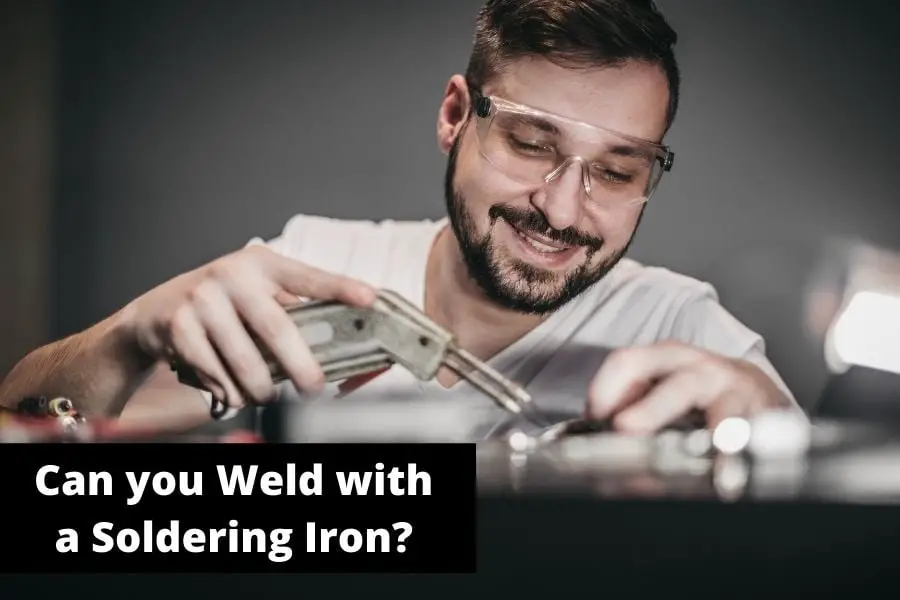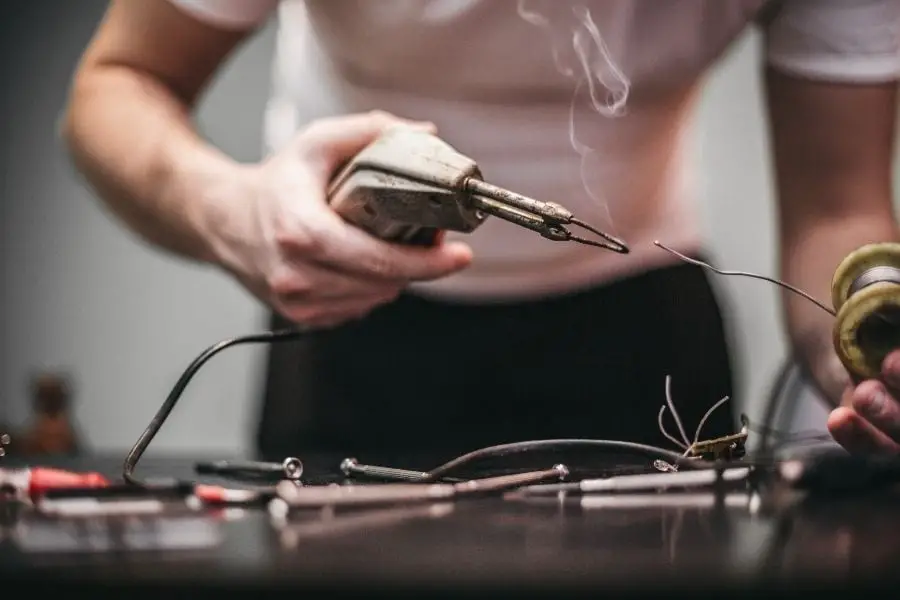
Welding machines and soldering irons have one thing in common. They both use heat to melt and then fuse metals or plastics. So, when you have something broken in your house that can be fixed just by a quick weld, you might be tempted to pull out your soldering iron. But, can you weld with a soldering iron?
You cannot weld metals with a soldering iron. The melting points of most metals are much higher than your usual solder alloy and soldering irons cannot generate the heat to weld them. But plastics with low melting points can be theoretically welded with a soldering iron.
In this article, you will find out in which case you can weld with a soldering iron and in which case you cannot. Moreover, you need to know the differences between welding and soldering to understand why you cannot weld with a soldering iron. Let’s find out these differences.
Difference Between Welding and Soldering
Welding and soldering are similar as both techniques of joining metals using heat. That’s why it is not surprising that the two terms are interchanged at times. But welding and soldering have subtle differences.
One big difference between welding and soldering is that the former requires the metals to melt completely, the latter does not. The other big difference is that welding does not need extra material to form a metal joint. But for soldering, you need soldering to form a new joint.
There are many differences between soldering and welding. These differences depend on factors such as temperature, metals and other materials used. Let’s look into some of these differences,
1. Temperature Requirements
You need a high temperature to completely melt and join two metals. Hence for melding, the required temperature has to be between 450°C to 3800°C.
Since soldering does not need the metals to melt completely, the required temperature is low. For soldering, the temperature has to be less than or equal to 450°C.
2. Type of Metals
Traditionally, you cannot weld two different metals together. For example, you cannot weld copper and steel.
You can melt copper to steel using the explosion welding method. Through soldering, you can join two different metals like copper and steel.
3. Filler Materials
Filler materials are metals, generally alloys that melt to help create a joint. In welding, filler materials are optional.
But for soldering, you need a third alloy or filler material to create a new joint. The filler material for soldering has to melt at a temperature lower than 450°C.
4. Usage of Flux
The flux is a mix of silicate and carbonate that prevents oxidation. Moreover, it shields the metal from the atmosphere and wets the metal for melting.
In the case of welding, the use of flux is not mandatory. But for soldering, the use of flux is mandatory.
5. Strength
A welded metal joint is as strong as any other metal. Soldered metal joints are not as strong as welds. Plus, if the soldering is not done well, the metal joint will not pass electricity properly.
So, when doing large projects, using solder to make joints is basically asking for trouble. Whatever you are building will break down.
Why You Can’t Weld with A Soldering Iron?
Welding two big chunks of metal using a tiny soldering iron is near to impossible. But you can try welding soft and malleable materials like plastic with a soldering iron.
The melting point of metals such as copper and steel are 1085°C and 1510°C. These metals need to completely melt in the welding process. But a soldering iron cannot generate enough heat to melt these metals.
For soldering you do not need to melt a material completely, nor do you need a high temperature. The melting point of most plastic is below 450°C. Hence, you can easily weld plastic materials with a soldering iron.
Moreover, welding is a process where you have to apply direct heat to the metals. If you want to join the two metals using a soldering iron, you will need a filler material that has a low melting point. But then you will risk welding a weak metal joint.
Welding is used while making stronger metal joints. A soldering iron used to join metals of a delicate electric circuit can hardly weld tough chunks of metal.
Welding and soldering have different uses and thus need different tools to function. The technique and effect of both of them are also different.
You need welding to build metal gates, fences, kitchen appliances and more. But you need soldering while working on fine objects like electric circuits. Hence, it is not recommended to use soldering iron to weld metals.

How to Weld Plastic with a Soldering Iron?
You may have a tough time melding metals with a soldering iron, but what about plastics? Plastics are malleable and with a little bit of heat from the soldering iron, you will be able to fix any broken pieces. So, if you have broken or scratched plastic that needs a quick fix, you can definitely use a soldering iron to patch it up.
Things You Will Need
You do not need to go out of your way to find the materials you will need to weld plastic. You will find most of these materials in your kitchen and welding toolbox.
- Degreaser
- Soap
- Sandpaper
- Plastic
- Soldering Iron
- Protective Mask
The Process
The outcome of a welded plastic may not be the best looking. But by following the given steps down to the T and with practice you can repair a broken plastic well enough for use. Here are the steps you need to follow,
1. The first step is to deep clean the plastic you want to fix. Even if it does not seem dirty, use soap and a degreaser to thoroughly clean it.
2. Using sandpaper, soften the jagged edges of the broken plastic pieces.
3. Plugin and preheat the soldering iron for use. It will only take a few minutes to warm up before it is ready for use.
4. Melting plastic can give off noxious fumes. That’s why we wear a protective mask and weld the plastic outdoors. Now, you are ready to start welding.
5. To start welding, push the two broken plastic pieces together. Then apply heat to them using the soldering iron. Melt the connecting edges of the broken pieces a little bit. While the plastic is warm, adjust and attach the two broken pieces.
6. Layer more plastic pieces on the joint. Keep pressing on the plastic pieces with the soldering iron till it melts completely. Spread the liquefied plastic pieces evenly over the joint with the tip of the soldering iron.
7. Lastly, go over the joint and the plastic around it with the soldering iron one last time.
Pro-Tip
Different types of plastics melts at different rates. So, try welding a few scrap plastics before welding the real thing. This way you will get a hang of welding plastic with a soldering iron.
Conclusion
We are always looking for newer and more convenient ways of getting a job done. But sometimes the traditional route is the only route. And so is the case with welding. Welding requires you to produce high levels of heat to melt metals and fuse them. Something the soldering iron is incapable of doing. So, it’s best that you stick to your welder for that.
I hope this article curbed your curiosity and answered any queries you had on whether or not can you weld with a soldering iron. Happy welding!
